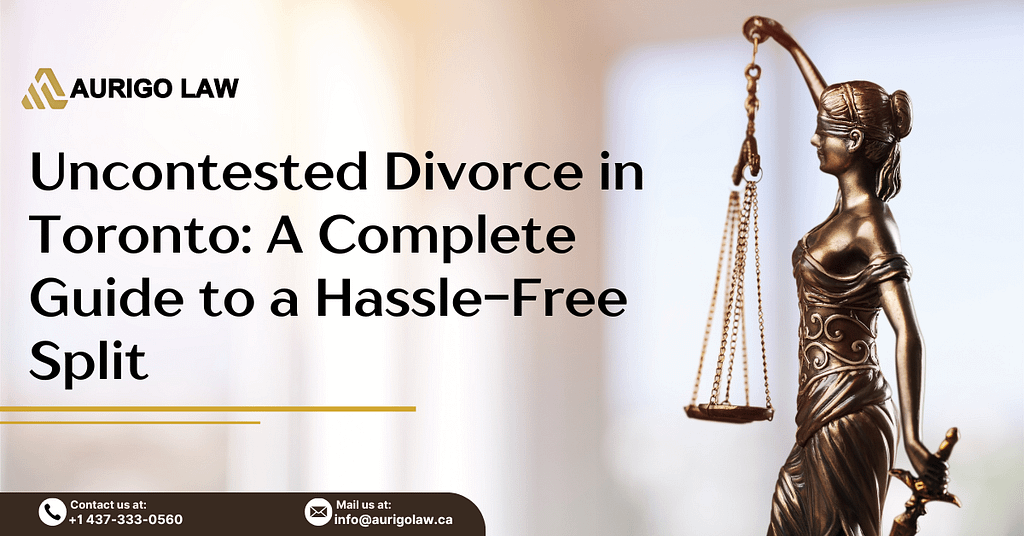
Cohabitation Agreement Legal Fees
Divorce can be emotionally and legally challenging, but if both spouses agree on key matters, an uncontested divorce can be a cost-effective and stress-free option. In Toronto, many couples choose this route to avoid lengthy court battles and expensive legal fees. This guide will walk you through everything you need to know about uncontested divorce in Ontario, from the step-by-step process to the common mistakes to avoid.
What is an Uncontested Divorce?
An uncontested divorce is when both spouses mutually agree to end their marriage without disputes over major issues such as parenting time, child support, and decision-making responsibility (if children are involved). In this type of divorce, neither party contests the grounds for divorce, which in most cases in Canada is one year of separation.
This process is usually faster, more affordable, and involves less conflict than a contested divorce, where spouses disagree on major matters.
Key Benefits of Filing for an Uncontested Divorce
- Lower Legal Costs: Since both spouses agree, you save on lawyer fees and court costs.
- Faster Process: Uncontested divorces are processed more quickly than contested cases.
- Less Emotional Stress: Avoiding court battles reduces stress for both spouses and children.
- More Control Over the Process: Both parties make decisions without court intervention.
- Predictability: With clear agreements in place, there are fewer surprises during the
process.
Step-by-Step Process of an Uncontested Divorce in Ontario
Step 1: Determine Eligibility
Before filing, ensure you meet the following criteria:
- At least one spouse has lived in Ontario for 12 months before filing.
- The couple has been separated for at least one year (unless adultery or cruelty is claimed,
which is rare in uncontested cases). - Parenting arrangements (child support, decision-making responsibility, and parenting time)
are agreed upon if children are involved.
Step 2: Prepare and File the Divorce Application
The application can be filed as sole (by one spouse) or joint (by both spouses together).
- A court filing fee of $669 is required.
- The application is filed at the Ontario Superior Court of Justice.
Step 3: Serve the Divorce Papers
Once the application is filed, you must serve a copy to your spouse, unless they co-file with you. They must sign an acknowledgment of receipt to confirm they’ve received the documents. Alternatively, personal service may be carried out. If the spouse acknowledges by signing the receipt of documents, personal service is not required. However, if the ex-spouse does not sign the acknowledgment of service, a third party (who is not the applicant) must personally serve the divorce papers. This method does not require the ex-spouse’s signature, as the process server provides an affidavit of service confirming delivery.
Step 4: Wait for the Response Period
- If the served spouse does not respond within 30 days (60 days if outside Canada), the
court proceeds with the divorce.
Step 5: Submit Final Documents and Obtain Divorce Order
- Once the waiting period expires, the final paperwork is submitted.
- The court reviews and grants the divorce if all requirements are met.
- The Divorce Order is issued, and after 31 days, the divorce is legally final.
Common Mistakes to Avoid in an Uncontested Divorce
1. Failing to Address Parenting Arrangements
For couples with children, parenting matters must be finalized before a divorce is granted. Parenting time, child support, and decision-making responsibility must be agreed upon. If these are unresolved, the court will not grant the divorce.
2. Incomplete or Incorrect Paperwork
Filing errors can delay or even lead to rejection of the application. Ensure all forms are correctly filled out and submitted.
3. Not Serving the Divorce Papers Properly
If the spouse is not served correctly or does not acknowledge receipt, the application can be delayed.
4. Not Knowing What Happens If the Spouse Refuses to Acknowledge Service
If the spouse does not acknowledge receiving the divorce papers, personal service can be carried out. If they are untraceable, a motion can be filed in court to dispense with service.
5. Expecting Property Division to be Automatically Settled
Unlike in contested divorces, an uncontested divorce does not automatically resolve property division or financial matters. While financial obligations can be settled later, parenting issues must be resolved first.
FAQs
If all documents are correctly filed, an uncontested divorce can take 3 to 6 months to finalize
If all documents are correctly filed, an uncontested divorce can take 3 to 6 months to finalize.
Do both spouses need a lawyer for an uncontested divorce?
No, but it’s recommended that each party seek independent legal advice (ILA) to ensure fairness.
Can I get an uncontested divorce if we still live together?
Yes, but you must prove that you are living “separate and apart” under the same roof.
What if my spouse does not acknowledge receipt of the divorce papers?
– You can serve the papers personally.
– If your spouse is missing or untraceable, you can file a motion in court to dispense with
service.
– If unresolved issues exist, such as property division or parenting arrangements, the exspouse may file an Answer to contest the case.
Are court fees included in the flat fee?
No, the court filing fee of $669 is separate from the lawyer’s flat fee.
An uncontested divorce in Toronto is an efficient and cost-effective way to end a marriage
amicably. However, it’s important to ensure all legal requirements are met, particularly parenting
arrangements if children are involved. Seeking professional legal guidance can help streamline the
process and avoid unnecessary delays.
If you’re ready to proceed with an uncontested divorce, book a free consultation today with Aurigo Law and get started on a stress-free legal process.
- Call Us: +1 437-333-0560
- Email: Info@aurigolaw.ca
- Location: 190 Parkhome Avenue, Toronto, Ontario M2R 1A2
